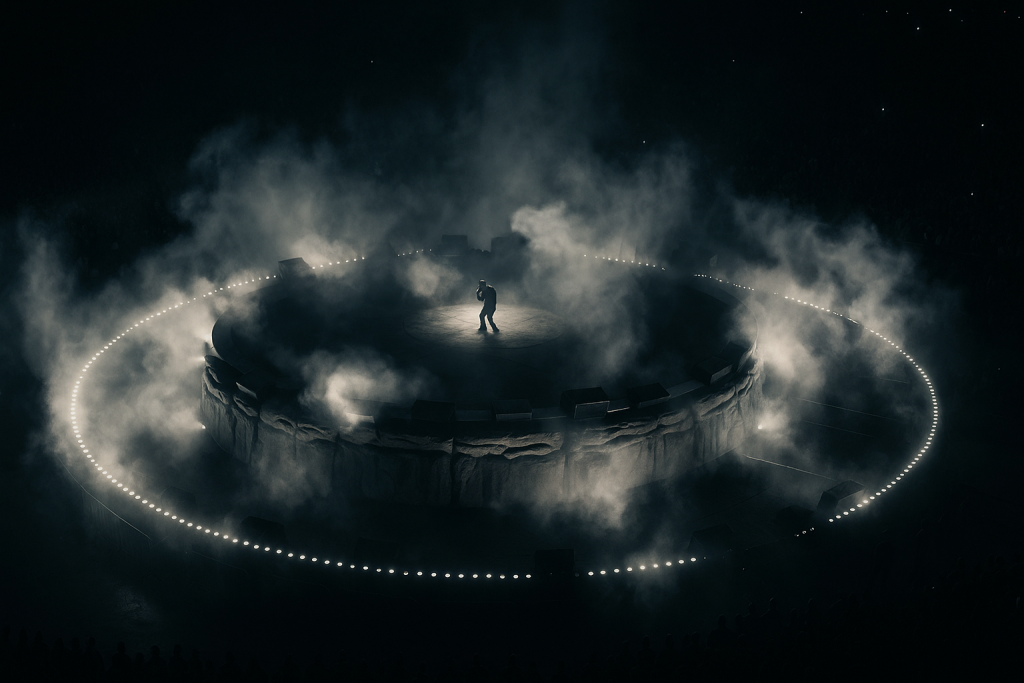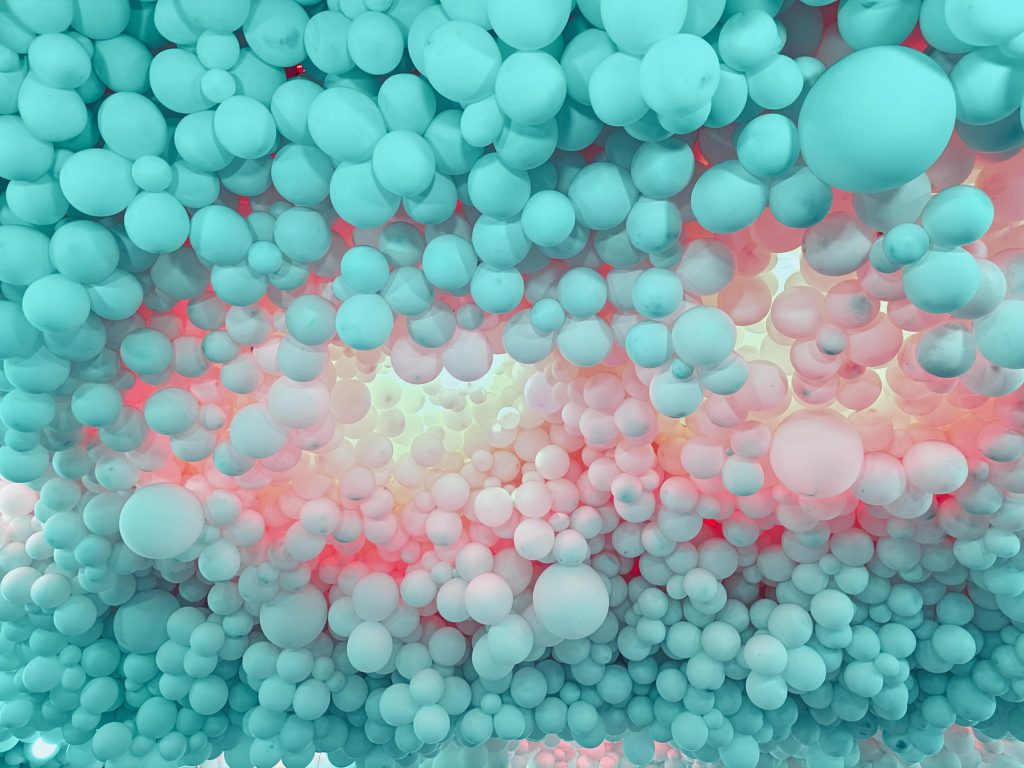Welcome to the Era of Non-Binary Scenography
How design, identity, and technology are reshaping the stage.
If you thought stage design was just an elaborate frame for performers, welcome to 2025. Here’s your tl;dr: It’s way more than that. Scenography has become a full-fledged performer with its own identity. Progressive visuals are the story. And this new visuality transforms stages into agents of identity, emotion, and innovation.
So, what does this mean for creatives in performance, fashion, and beyond? Let’s dive into the key takeaways from my recent Instagram breakdown on this concept.
Scenography as Performance“It’s alive, evolving, pushing back on the show and the audience’s assumptions.”
Progressive Visuals reject neutrality. The scenery now carries narratives, embodies identities, and reshapes the audience’s emotional journey. At the core of progressive visuals is the radical notion that design is felt, it adds to the rhythm and emotional structure of a show. This visuality taps into the raw, often elusive forces of desire, identity, and transformation. Desire, like scenography itself, is never static—it shifts, pulses, and pushes boundaries. In this approach, every visual element becomes a conduit for unspoken emotion and conflict, a tool for breaking free from the constraints of traditional, linear narrative.
Take the notion of trans-aesthetics—a key player in the visual revolution. These aren’t your typical clean-cut, symmetrical visuals. Instead, they embrace a fluidity that mirrors the non-binary and post-digital experience. The glitch is the ultimate metaphor here—mistakes are reprogrammed and no longer just accidents; they’re charged moments of truth. As the glitch fractures the image, it opens up space for transformation. This is a celebration of incoherence, fragmentation, and, above all, freedom. They’re authentic. Glitch aesthetics, then, aren’t just visual errors; they’re a disruption of the rigid, hegemonic narratives of beauty and form, an act of rebellion against the perfectly polished and prescribed.
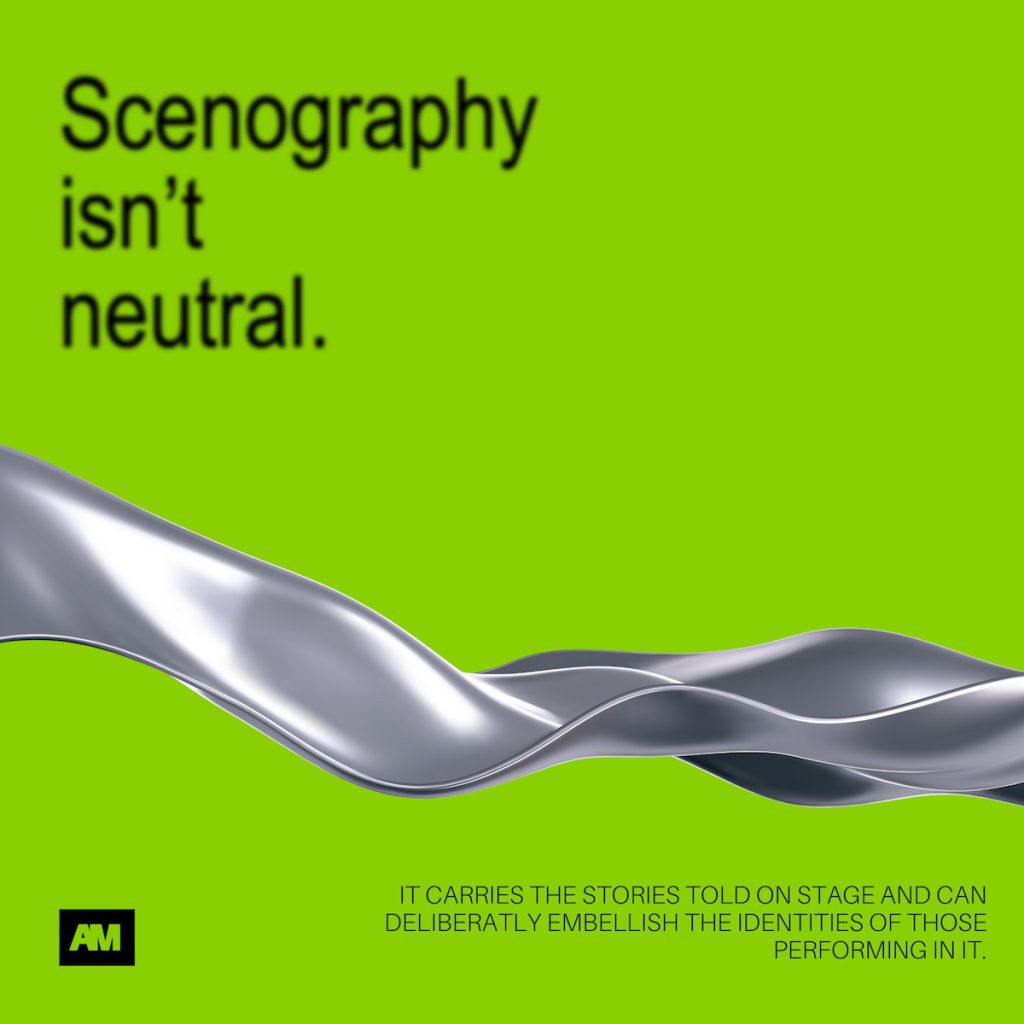
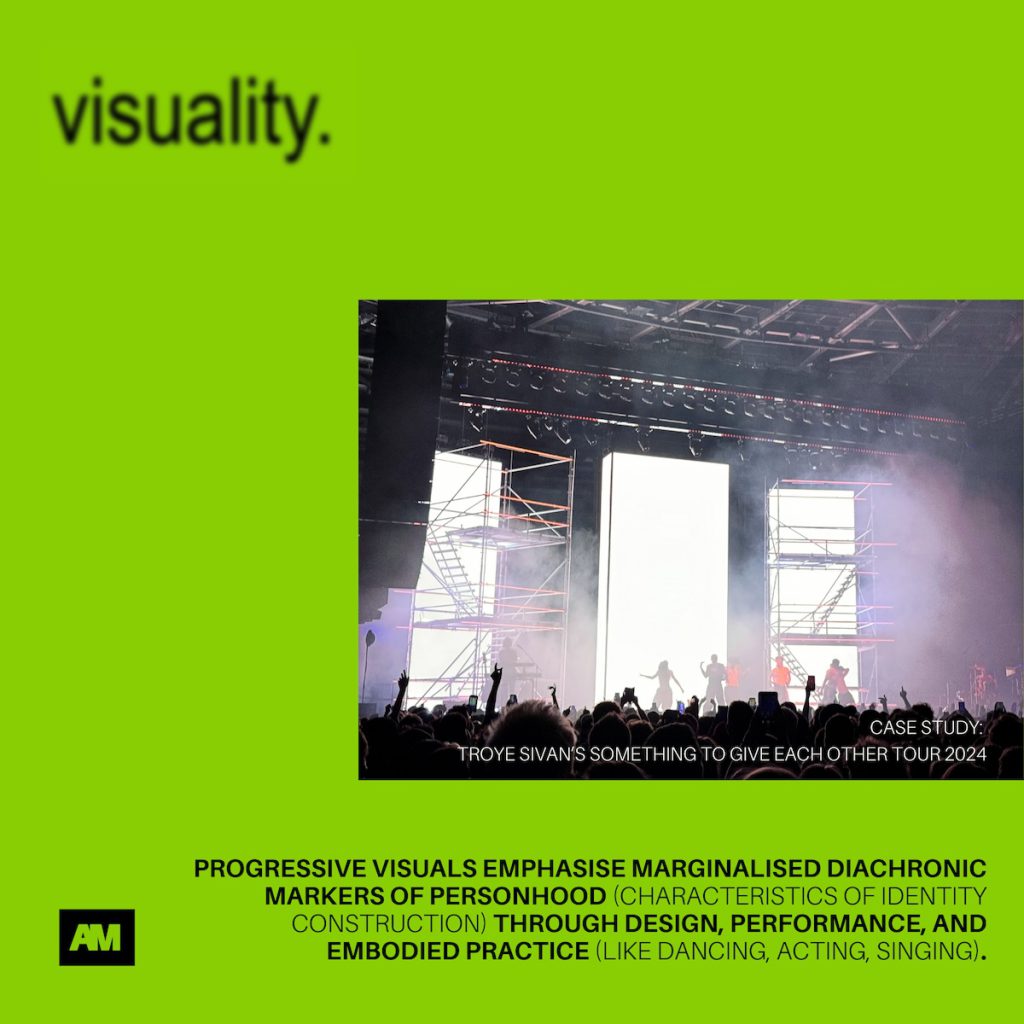
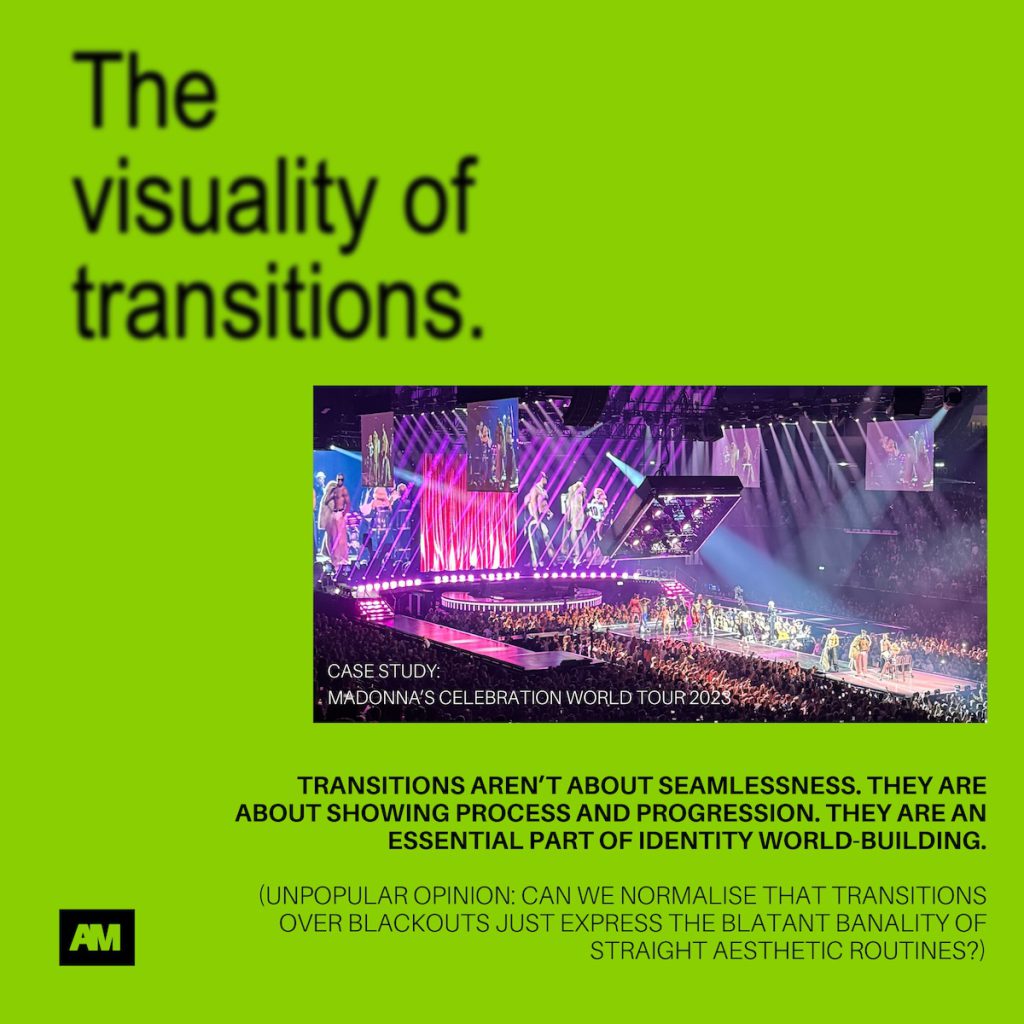
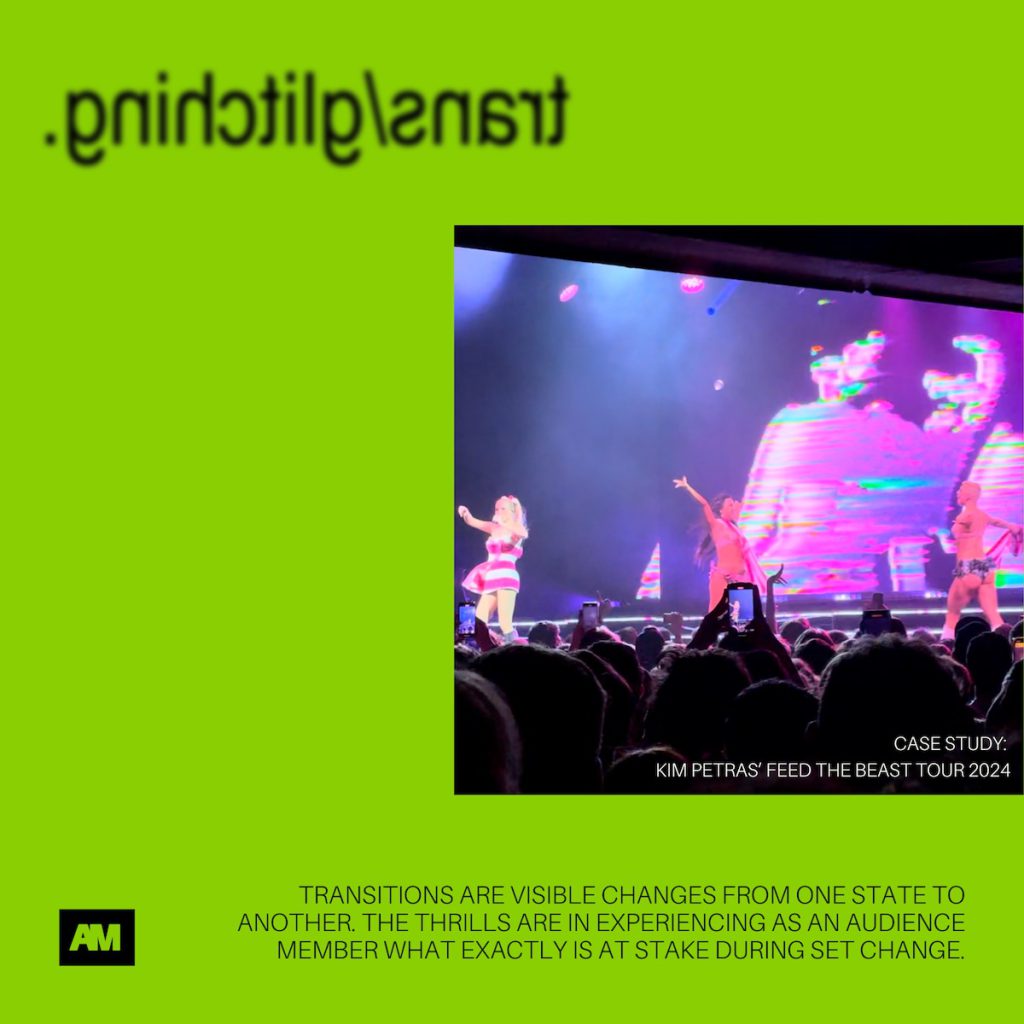
Desire and Scenography
Scenography isn’t neutral—even more so, it actively manifests and challenges human desires. Typography, set transitions, and digital design communicate desires that are as fluid and dynamic as identity itself.
Scenography scholar Rachel Hann remarks that “what makes scenography so compelling is its dual nature—it both represents reality and reimagines it” (read the source). In line with this thought, I see scenography in modern stage shows as being a force that manifests the desires of both the performer and the audience. Just as human identity is constantly evolving, so too is the space in which it’s performed. The way a space looks, feels, and reacts becomes a direct reflection of the desires, struggles, and transformations happening on stage. Desire in this context is an active, palpable presence that informs and shifts every aspect of design.
Typography to SPELL – IT – OUT!
Typography, often overlooked in traditional scenography, becomes a vocal character in this realm. The text on screen or projected onto the stage isn’t merely about communication—it’s an embodiment of desire itself. Whether it’s bold and aggressive, whispering subtly in the background, or disrupting the visual flow with sharp contrasts, typography commands attention. It speaks volumes about the urgency, the tension, or the unspoken yearnings of the characters and the narrative. Every curve, every line, is an extension of emotional tension, acting as both a signal and a provocation to the audience. It says, “Look here, feel this, desire this.”
TRANS-itions. Get it?
Set transitions are another powerful tool in manifesting desire. Gone are the days of seamless, invisible shifts between scenes. In progressive scenography, transitions become moments of visible change—a reflection of the desire for something new, something unknown. The way one space dissolves into another is all about exposing the very process of transformation. As one world melts away, another is born, and the audience is made acutely aware of the emotional stakes in this shift. This process to actively construct emotive processes by means of scenography taps into a deeper, more visceral layer of transformation, mirroring the flux and fluidity of human identity itself. Desire, then, is experienced in the very movement of the space.
Glitch it up!
In the digital age, digital design becomes a potent partner in these explorations of desire. Projections, animations, and augmented environments no longer just serve as flashy visuals—they represent the ever-changing state of human emotions and aspirations. Digital elements transcend traditional limits, offering new opportunities to play with time, space, and perception. Consider the use of glitch aesthetics—a digital malfunction that, in this context, is embraced rather than discarded. These glitches represent disruption and transformation, aligning perfectly with the fluid nature of desire and identity. As glitches distort the visual world, they create a space where emotions, desires, and narratives can break free from traditional, linear structures. They are a celebration of imperfection, an acceptance of the chaotic beauty inherent in human emotion. Through these visual devices, scenography embodies desire, turning the space itself into an agent of transformation.
Dismantling Aesthetic Routines
Progressive scenography rejects the idea that transitions should be invisible or overtly seamless—after all, the art of theatre is rooted in spectacle and surprise, innit? Rather than covering up the mechanics of scene changes with bland blackouts, it embraces visible set changes that act as performances in their own right. These moments of transition are invitations to experience the transformation—of both the space and the narrative—at full force. Think of them as deliberate pauses in the chaos, where the very act of shifting worlds becomes part of the story. Rather than masking the process, these visible changes expose it, revealing the how behind the illusion. This approach challenges conventional aesthetic routines, where transitions go over black or are over as quickly as can be made possible, and instead puts them at the forefront of the experience. The result is a stage that feels alive with energy, constantly shifting, evolving, and never settling into complacency. In these moments, the audience becomes fully aware of the artifice, but instead of detracting from the experience, it deepens the connection, heightening the tension and excitement as each new transformation unfolds.
For those who like to watch!
Progressive scenography dares to disrupt traditional (read: conventional and patriarchal) aesthetics, which we are now unlearning through scenographic practice. We can see this all over pop in the last 5+ years. Visuality is about process, it’s about showing visible evidence of desire, identity, and our place in the world. The result? A stage alive with flux and energy.
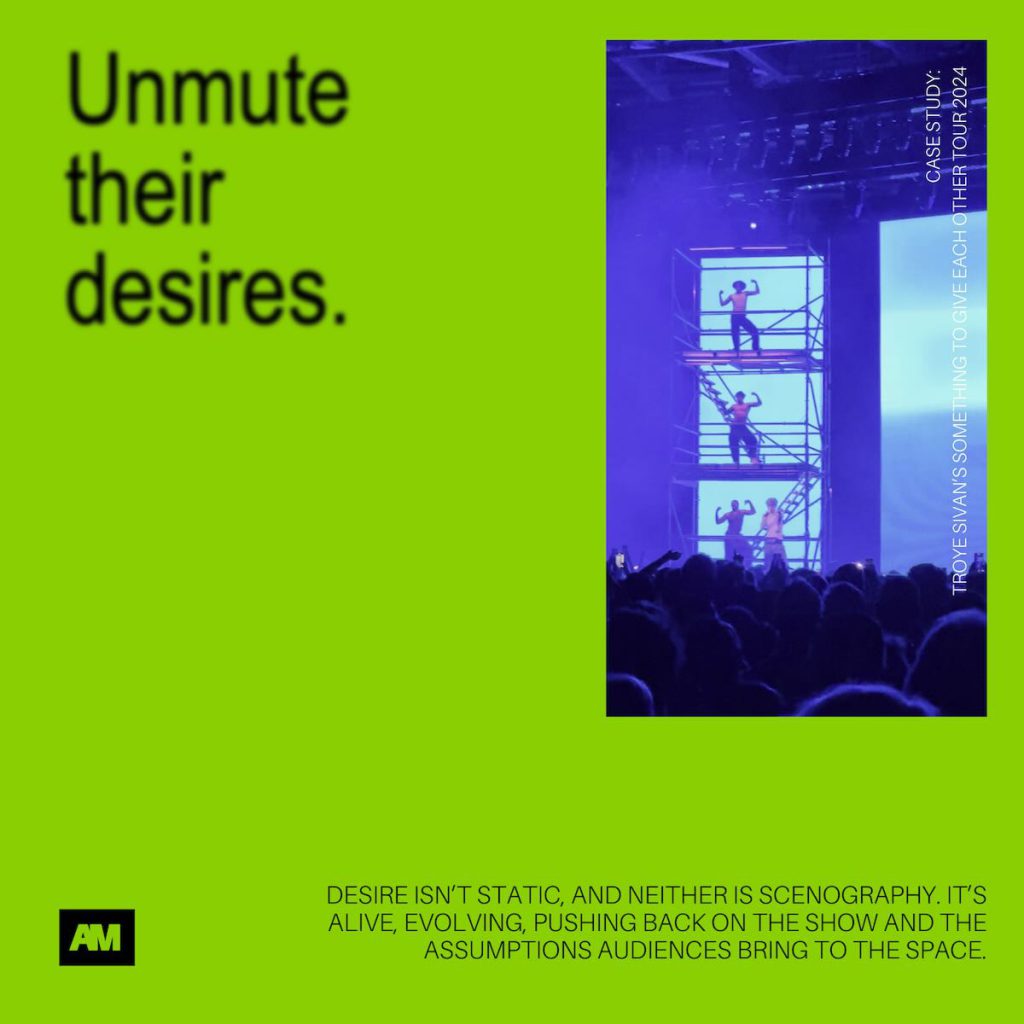
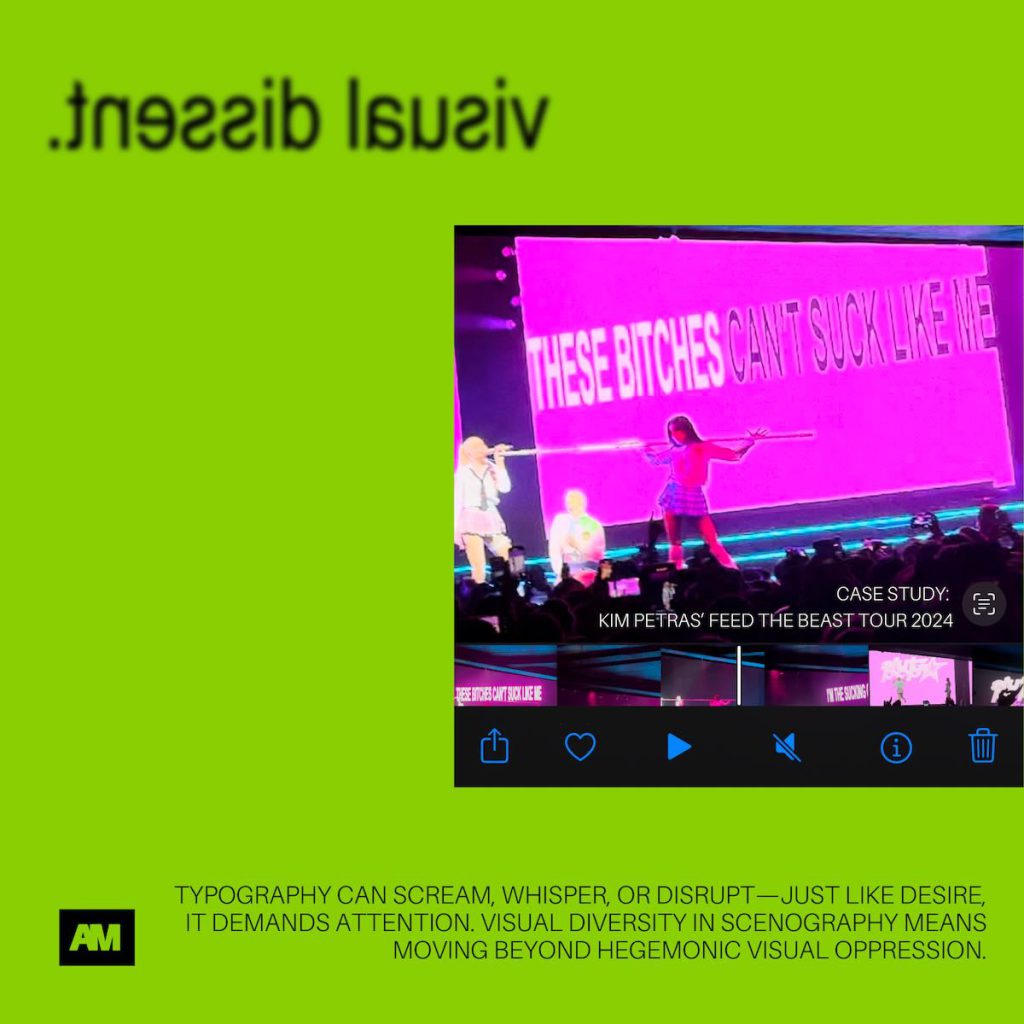
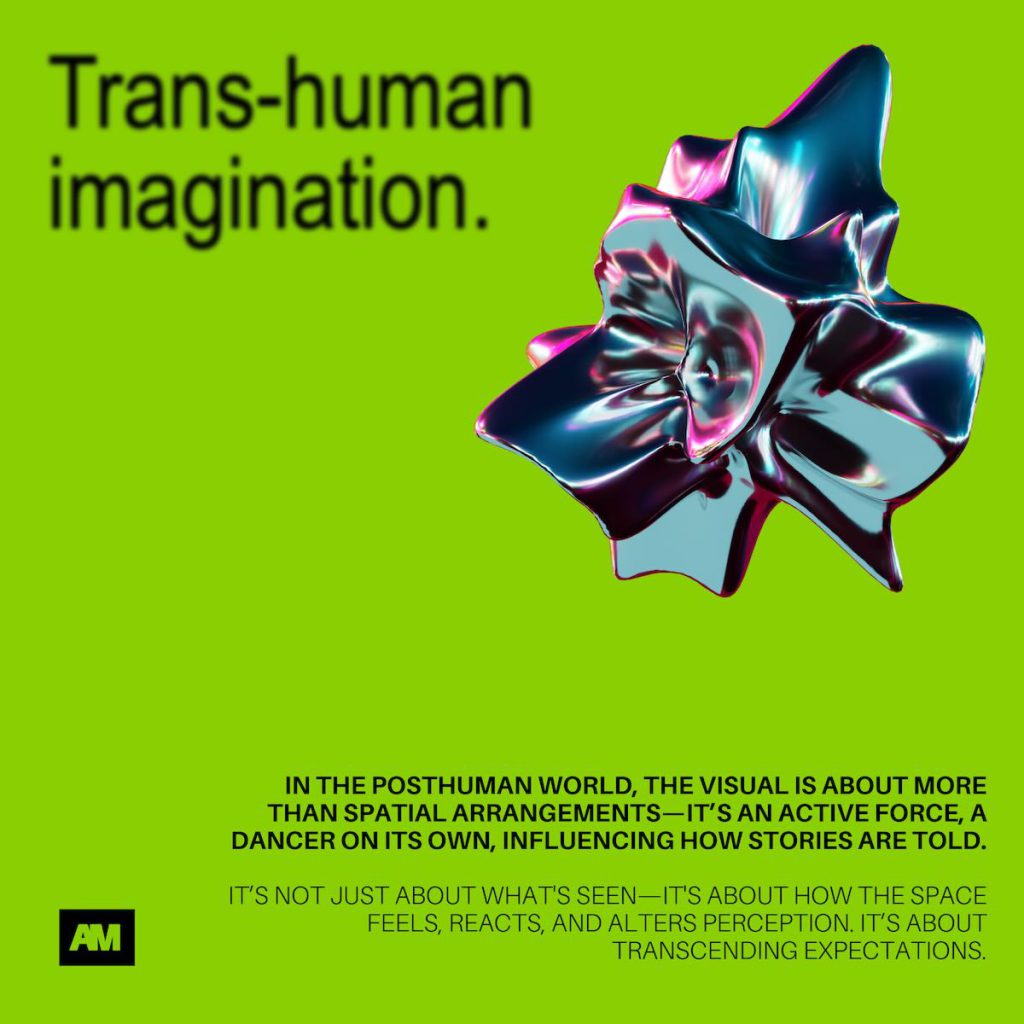
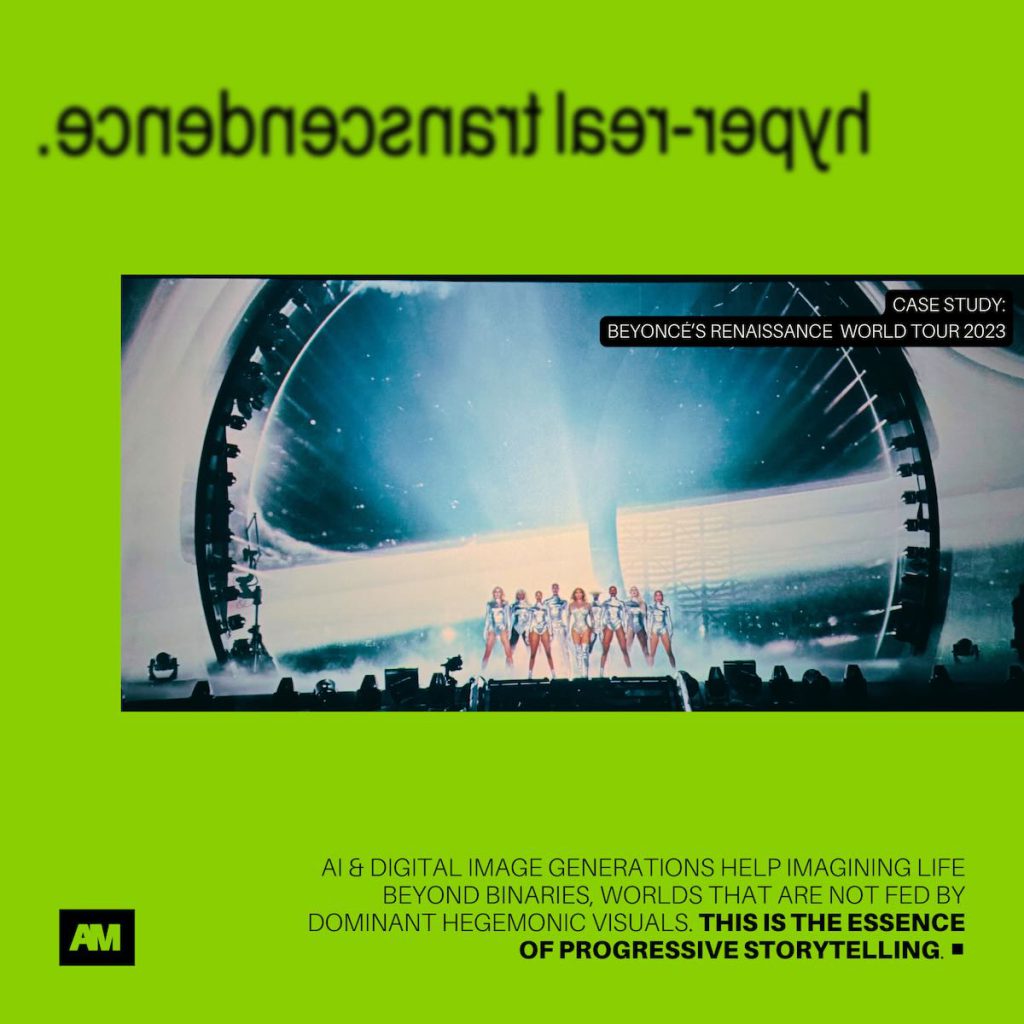
The Post-Human Stage
When we speak of trans-human imagination, we’re talking about visuals that transcend human biology, challenging what we believe the limits of the body and mind can be. Especially in an age of digital generation of visual content, “anything is post-human” – I hear you say. Well, not quite. It means re-imagining the human experience altogether. With digital imagery that doesn’t obey traditional rules of reality, scenography becomes a playground for hyper-real environments that reflect the freedom and fluidity of modern identities. Think of it as a dance between the physical and the digital, a movement toward something that’s both beyond the human and yet entirely reflective of human desires to transcend, to evolve, and to express yourself… again, maybe even outside of straight confines and biological realities. Because, you know, why should creativity be confined by reproductive metaphors? Exactly.
Progressive visuals embrace AI, hyper-real animations, and post-human aesthetics to imagine realities that defy binaries. It’s a conscious layer of storytelling, rejecting hegemonic norms to make space for new ways of being.
These visuals invite the audience to emotionally interact with a world that is alive, constantly changing, and at times unsettling. The space is as much a part of the story as the performers. It desires to be seen, it desires to be felt, and it desires to unsettle preconceived notions of identity and performance. And as this desire grows, so does the tension—it’s in the transitions, the glitches, the impossible forms and figures that never quite settle into the expected. These visuals can provoke deep, existential reflection – depending on the amount of K you took to the party. – Well, let’s keep it PG.
Go-To Checklist for Progressive Visual Show Design
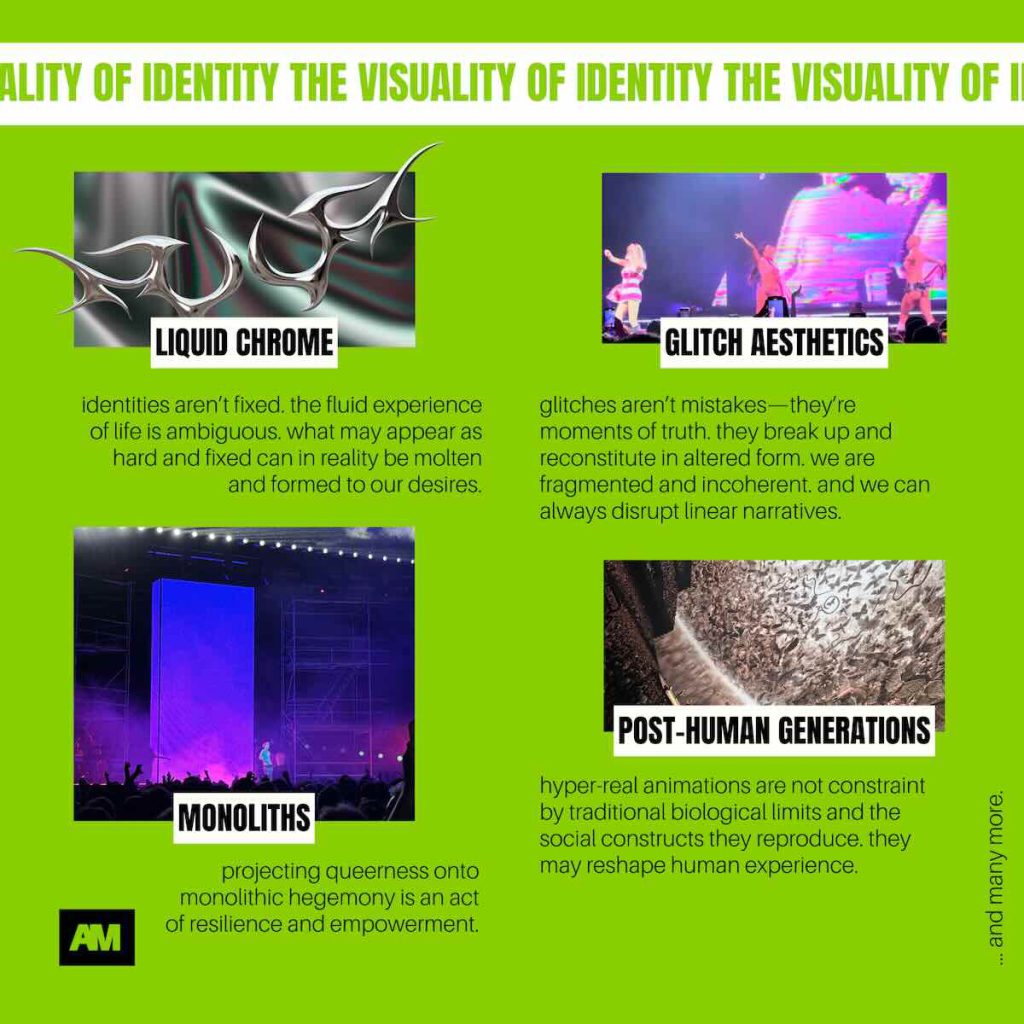
For designers looking to embrace progressive visuals, here’s your cheat sheet:
1. Start with YOUR story: How can your visuals actively move your narrative core forward? How can it actively assume a stance that reveals a part of your self.
2. Embrace fluidity: Use materials and designs that shift, flow, and disrupt fixed perceptions.
3. Leverage glitches: Mistakes and interruptions are design opportunities. Celebrate them.
4. Challenge transitions: Avoid seamless blackouts; make set changes a spectacle.
5. Dive into identity: Create visuals that embody, disrupt, and reclaim identities.
6. Adopt post-human aesthetics: Incorporate AI, digital design, and hyper-real visuals to imagine beyond human constraints.
7. Engage desires: Use typography, lighting, and movement to provoke emotional and intellectual reactions. Demand their attention!
In 2025, scenography is starring in your show – right next to you. Ready to bring your visuals to life?
Images by Andy Machals, shot during concerts of Troye Sivan, Kim Petras, Beyoncé, Madonna, and in MSG The Sphere in Las Vegas with designs by Es Devlin.
Read On: In her recent book BEYOND SCENOGRAPHY, Rachel Hann (Associate Professor of Performance and Design at Northumbria University, Newcastle) offers a manifesto for a renewed theory of scenographic practice for the student and professional theatrical designer, and it’s worth all your money and time.


